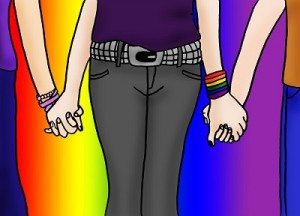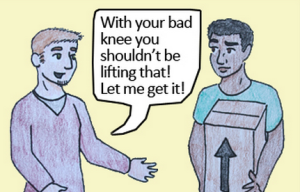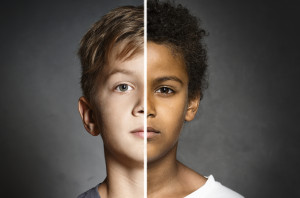
Source: Wikipedia
Those four little letters can cause quite the stir.
They have been colorfully portrayed in film, television, and music in various ways. There are clandestine whispers about them in close company.
But what are they, exactly?
In a culture in which human sexuality is a paradox — everywhere and nowhere, all we can discuss and all we fear talking about — BDSM inevitably becomes a bit of a mystery. And where there is mystery, there is myth.
BDSM is an acronym that stands for Bondage & Discipline (BD)/Dominance & Submission (Ds)/Sadism & Masochism (SM).
For some people, it is strictly a lifestyle. Others feel that, for them, it is more of an orientation, something that is inherently a part of who they are.
As the name suggests, BDSM is not one thing. It encompasses many different acts, fetishes, and mentalities.
The community itself is also just as diverse in terms of race, a/sexual orientation, gender, class, size, age, and so much more.
However, because human sexuality is often difficult to talk about and there are so many misconceptions about BDSM itself, there are also a significant amount of untruths about the people who comprise the community.
These myths and misconceptions inevitably lead to misunderstanding, shaming, and silence.
It is important to discuss kink from a feminist perspective because of the harm that misinformation about our desires, likes, and dislikes can cause.
This misinformation can lead to feelings of disempowerment in one’s a/sexuality as well as in relationships, low self-worth, unfulfilling connections, and confusion, among other things.
Mental and a/sexual health and wellness should be part of the foundation of any intersectional feminist movement.
Why?
Because cis women, trans women and men, non-binary people, queer people, people on the asexual spectrum, and people of color are historically ridiculed, shamed, maligned, punished, and silenced for our a/sexuality.
The kink community is comprised of people from all of those groups, and then some. So to help understand this community a little better, here are three myths and corresponding truths about BDSM.
Myth 1. BDSM Is All About Sex
If one were to rely on pop culture references to understand BDSM, it makes perfect sense that many people believe that it’s all about the act of sex.
However, the truth is that sex is not the whole picture, and for some, it isn’t in the frame at all.
For many sexual participants, the attraction to, and participation in, various aspects of BDSM (bondage, being a Dom[me], submissive, or a switch, masochist, and so on) stems from the mental experience as opposed to the physical, either situationally or in more extended circumstances.
And of course, need I mention that many people on the asexual spectrum are also a part of the BDSM community?
Their experiences as members of the kink community can be completely erased when one believes that only sexual people can participate because “BDSM is about sex.”
What does “the mental experience” encompass?
It’s different for different people; however, for many, the mental aspects of BDSM are about power exchange, vulnerability, and trust. Some would argue, and I agree, that a healthy kinky relationship cannot exist without the last two aspects.
When we erroneously believe that BDSM is only or always about sex, we erase people’s experiences, desires, and feelings.
The best way to understand what BDSM is about (and what it’s not about) – like any other underrepresented group — is to make the effort to learn more.
Seek out books and online resources, find spaces that may be open to non-kinky people (such as local or online workshops — always ask first and respect the space!), and if a friend feels trusting enough to tell you that they are a member of this community, listen to their experiences and feelings with an open mind.
Myth 2. BDSM Is Inherently Abusive
This myth is very common, but also complicated to discuss because the truth is that there is abuse in the kink community, just as there is in any other community or group of people.
Healthy kinky relationships are founded on clear communication, consent, and regular negotiation, but some people deliberately use BDSM to manipulate, exploit, overpower, and abuse.
The images of people who are marginalized — including those perceived as sexually “deviant” — are controlled by those with social privilege.
Because of this, concepts like dominance and submission, power exchange, and similar subsets of BDSM are warped in the average person’s mind.
Particularly because many victims of abuse within the kink community refuse to seek help for fear of being judged for what they do like and blamed for their predicament (or not believed at all), it is imperative that we can distinguish between aspects of BDSM and abuse.
As a bisexual/queer, fat, kinky woman of color, I will be the first to say that I think that abusive relationships within our wonderful kinky community need to be addressed more.
In one of several BDSM online communities of which I’m a part, I recall one woman relaying a story about an incident while she was out shopping.
She was in the parking lot on her way home when a concerned citizen saw bruising on her body (from kinky play) and asked her if she was okay and needed help.
She appreciated the person’s concern, but reassured them that she is just kinky — the marks were from consensual acts.
Her point was to critique the tendency of some kinky people to get up in arms when people assume that they are in abusive relationships, feeling misunderstood and judged by a society that isn’t too kind to sexual minorities.
But the kind of proactive intervention displayed by that concerned citizen is precisely the kind of participation that we need in a society that is often too silent when it comes to intimate partner violence, within and outside of the kink community.
However, to insist that the foundation of an entire subculture is based on abuse erases people’s autonomy and self-determination and invalidates the experiences of many people in healthy kinky relationships.
In addition to the steps you can take outlined in myth #1, specifically take the time to learn about power dynamics within the kink community.
As with all abuse, there are signs which can often be distinguished from consensual submission and rough play found in some kinky relationships.
No matter how a relationship is structured, all relationships require communication, mutual respect, and trust.
Myth 3. People in the BDSM Community Have a History of Abuse or Other Trauma
This one is inextricably tied to the previous myth.
People with a history of abuse or trauma, such as myself, exist in all communities.
So of course there will be kinky people with a history of abuse and trauma, just as there are kinky people with and without college degrees, kinky people who like or hate pizza (we ignore the latter, for the record), and kinky people across religious and political spectrums.
People who aren’t in, or informed about, the lifestyle assume that if you like to dominate or be dominated in the bedroom (especially the latter), if you enjoy pain or being gagged or tied up, there must be something “wrong” with you.
“What happened to you?” is the common refrain.
The problem with this myth, besides the fact that it paints an entire community with a very broad brush, is the fact that it rests on the assumption that people with a history of abuse and trauma couldn’t possibly make healthy, informed decisions relating to their a/sexuality.
Furthermore, it often rests upon the idea that there is something wrong with us, as opposed to something wrong with the perpetrator(s) — that we are damaged, broken, or otherwise incapable of functioning, on some level, in the “real world.”
While experiencing abuse and trauma certainly comes with its own set of challenges, and some survivors would suggest that there are certain things that you cannot “get over” with time (it always stays with you no matter what), these challenges don’t preclude us from the ability to successfully navigate our lives and develop into healthy people.
To suggest otherwise is insulting at best and oppressive at its worst.
This myth pathologizes an entire group of people and is based on pseudo/pop psychology in the worst form possible.
We can begin to move away from this tendency by reminding ourselves that everyone grows into their a/sexuality at their own pace, has their own baggage, and has the right to make their own decisions when it comes to their bodies, sex, and relationships.
For some, certain aspects of BDSM may be a kind of catharsis, to take back the consent that was once taken away from us (and that’s okay).
But for many in the community, our attraction to kink has nothing to do with healing — because there is nothing to heal from. For many of us, it is simply about what feels good.
When talking about human sexuality, what we perceive to “feel good” (or not) may be influenced by many things (biology, culture/upbringing, religious/spiritual beliefs, society, media), but ultimately it is up to each individual to decide what works for them.
Within the context of relationships — kinky or otherwise — again, it is imperative that we clearly communicate, negotiate, and respect consent in order to create and maintain safe intimate spaces.
***
Perhaps the most important reminder is bound up (!) in a phrase I first learned as a student leader at Rutgers University: “Don’t yuck my yum!”
There are certain things that everyone likes or dislikes — I love chocolate cake, while my cousin is not a fan. And that’s okay.
The moment we decide that because what someone likes (or doesn’t like) is different it deserves shaming, judgment, or ridicule, that is the moment our feminism — and our social justice — becomes exclusionary.
We must be ready to empower our whole selves in whatever decisions make the most sense for us so that we can focus on the revolutionary work that needs to be done.
Take care of yourselves.
[do_widget id=”text-101″]
Denarii Monroe is a Contributing Writer for Everyday Feminism and a poor, fat, bisexual African-American cisgender woman with multiple disabilities in her late 20s. A native New Yorker, she has been involved in social justice activism in some capacity since her days as a queer student leader at Rutgers University. Denarii is a syndicated writer for BlogHer.com and an aspiring screenwriter with a passion for youth and young adults. She likes dogs, cats, and bunnies. She loves eggnog, wine, horror films, and Hanson (yes, Hanson). She loves to laugh, dismantle oppression through art, and make all kinds of love.
Search our 3000+ articles!
Read our articles about:
Our online racial justice training
Used by hundreds of universities, non-profits, and businesses.
Click to learn more
Most Read Articles
- « Previous
- 1
- …
- 30
- 31
- 32



















